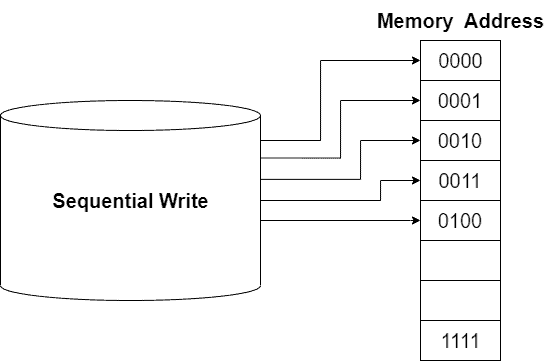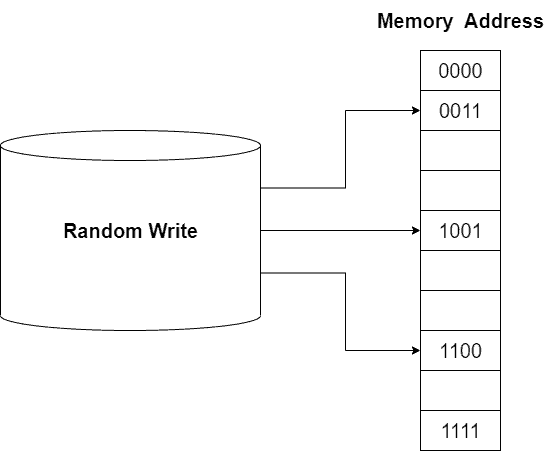Yes, we're now running our Black Friday Sale. All Access and Pro are 33% off until 2nd December, 2025:
Differences Between Sequential and Random Writes of Memory
Last updated: March 18, 2024
1. Overview
In this tutorial, we’ll discuss two writing methods that can significantly impact storage performance: sequential and random writes.
Furthermore, we’ll present the key differences between them.
2. Introduction to Sequential Write
Read performance is often the bottleneck for storage in almost all data-intensive applications, from streaming analytics to virtual reality and game engines. While flash continues to improve performance, it’s evident that we need more innovation. The new generation of storage must be intelligent and meet the growing needs of the digital world.
When we write data sequentially to a storage device, we’re more likely to achieve higher performance as compared to writing data in a random manner. The storage media is optimized for sequential writes. Hence, we can expect higher performance. Sequential writes can take advantage of the total capacity of storage devices.
The major difference between sequential and random writes is the order in which data is written to the storage device. Using sequential writing, we can write data starting at the beginning of a memory:

Sequential write is used in disk-based drives. The architecture of a disk-based drive supports writing data in an orderly fashion. If the computer operator wants to move existing data blocks to new physical memory locations, the computer operator must rewrite them in order to move the data. A disk-based derive can transfer data to the computer’s memory in the same order in which the computer operator writes data to the disk drive.
A disk-based drive can write data at the same rate as the computer operator types information on the keyboard or reads data from a disk drive. Additionally, it can write data sequentially to allow for shorter access time.
We store data on a disk drive in a series of concentric circles called tracks. Furthermore, we can retrieve information from the disk drive by moving the read/write head to the correct track. Additionally, we must follow the data path from the outer circle to the inner circle until the desired data is reached. We further divide the tracks into sectors.
If the computer operator writes data to a disk drive in sequential order, accessing the data is a sequential process.
3. Introduction to Random Write
When we write data randomly to a storage device, we’re likely to achieve lower performance compared to sequential writing. Random writes can’t take advantage of the full capacity of the storage device. Unlike sequential writing, random writes jump back and forth across the device memory, creating a scattered data pattern with no clear starting point:

We use random write in solid-state drives. A solid-state drive system is designed to write data without following any order. A computer operator can write a large amount of data simultaneously to a solid-state drive. The computer operator can then write the data in any convenient order. A solid-state drive can write data and verify whether the data is written correctly or not concurrently.
A solid-state drive system can write data at a very high rate. The possible explanation for the high data rate is that it can write data in random order as well as verify the correctness of the data at the same time. Additionally, a solid-state drive can write data without following an ordered procedure.
4. Differences
Flash storage has become a significant part of the data center fabric and plays a vital role in the data industry. Understanding the difference between sequential and random writes is important to build a storage system that can handle the complexities of modern data centers and cloud environments.
The main difference between sequential and random writing is the order in which we write the data in the memory. As we discussed, using sequential writing, we can start writing data at the beginning of the memory following an order. On the other hand, a random write creates a scattered data writing pattern with no clear starting point in the memory. Most importantly, a sequential write takes advantage of the full capacity of the storage device, while a random write only utilizes a portion of the device’s capacity.
Let’s take a look at a list of core differences between sequential and random writes:
| Sequential Write | Random Write |
|---|---|
| Results in continuous stream of data | Results in fragment of data |
| Follows an order while writing in memory | Doesn’t follows any order while writing in memory |
| Utilizes the entire storage device’s capacity | Only a small percentage of the device’s capacity is utilized |
| Takes less time than random write | Take longer to finish compared to sequential write |
| Must wait until all of the data on the storage device has been written before moving on to the next chunk of data | No need to wait for the completion of writing the current data chunk before moving to the next chunks |
5. Conclusion
In this tutorial, we discussed two writing methods for memory: sequential and random writes.
Furthermore, we presented the core differences between them.